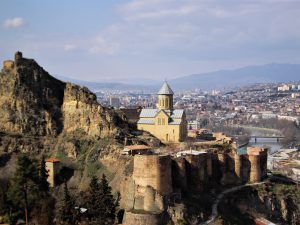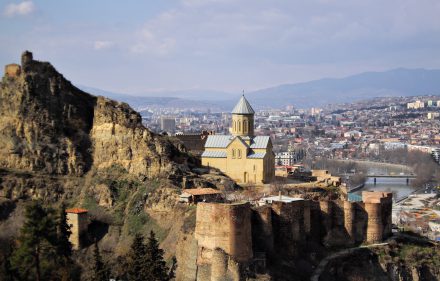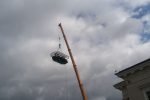
Having heard numerous witnesses, the scholar claimed: Armenians in their new living places without any remorse took over former Georgian churches and turned them Armenian.
To reclaim the cursed
In the beginning of 2015, Patriarchs of Armenian Gregorian Church sent a letter to Georgian government listing 442 churches in Georgia, both standing and destroyed. The letter demanded subordination of all these churches and land beneath them to Armenia.
One year later, Armenian Catholic Church asked State Agency for Religious Affairs of Georgia to release 23 churches located in Georgian territory that are being attended by local Armenian Catholics. Georgians were not surprised by such move. In summer 1995, in Yerevan, a catalogue named “Armenian churches in Georgia” was published. According to publishers, there were as many as 653 churches in Georgia that should belong to Armenians.
A well-known Georgian scholar Bondo Arveladze (Бондо Арвеладзе) wrote a huge article about this catalogue, where he thoroughly discussed the known facts about few dozens of the aforementioned churches: if not the majority, then more than a half of listed churches are of Georgian origin butremadeto be Armenian. We could say, that professor draws a publicistic conclusion: It would appear, that not Armenians lived among Georgians, but, on the contrary, Georgians settled among Armenians in the blessed land of Iberia. In addition, he makes a prophecy: If not at the moment, then some years later Armenians will present this “document” and then, presumably, they will also want to claim Svetitskhoveli (the Cathedral of Patriarch of Georgian Church, one of the most important spiritual sites of Georgian Orthodoxy, that was built in the 5th century and rebuilt in the first half of the 11th century). As we can see, everything happened as prophesized.
Georgian journalist Iranda Kalanadze makes a point that Armenian Churches of both confessions declared their claim to Georgian churchesat an important time – a visit of the Roman Pope Francis to South Caucasus was due. Armenianshad not received a proper response and the journalist blamed Tbilisian higher-ups and Georgian society: Why do you stay silent?
One that does not stay silent is Georgian historian Guram Markhulia (Гурам Мархулия), who consistently fought against fake facts delivered by Armenian representatives of science and culture. He reminded: after Catholicos Abraham (Абраам I) of Armenian Church cursed Georgian people in 607, it was forbidden in Georgia to build churches of Armenian confession (which was treated as heresy) till 1801 when Georgia fell under Russia‘s dominion and lost its statehood; an Armenian could not enter Georgian churches. In 1811, Russian emperor canceled the independence of Georgian Orthodox Church and joined it to Russian synod. A letter from Etchmiadzin administration claims almost all indicated churches as build in the 19th century. It would look like more than 600 churches were built in Georgia in 100 years! It is not even debatable if such a feat can be accomplished, because, according to Markhulia, all these churches were built in the 11th-18th centuries.
Moreover, Markhulia explained why it isdemanded from Georgia to return only 442, presumably, Armenian churches instead of all 653. It appears, that 221 churches are in Russian occupied Abkhazia and South Ossetia (North Kartli). Thus, additionally, this Armenian document does not recognize occupied Georgian provinces.
Borrowed chickendrives away owned ones
At the moment in southern regions of Georgia Meskheti and Javakheti (Samtskhe-Javakheti region in earlier centuries) Armenians make about one half of their population. In Akhalkalaki town, located in the south of aforementioned region, almost all citizens are Armenians. In the beginning of the 21st century, town’s people erected a monument for Armenian Archbishop Karapet Bagratuni. Karapet is a real leader of Armenian people: in 1829-1830 he guided 7,298 Armenian families (about 50,000 people) from Erzurum region in Turkey to Javakheti and some other regions of South Caucasia, where most of the population was gone because of war. Georgians condemn the Archbishop: Georgian Muslims that lived in Javakheti lost their homes and had to seek shelter in regions belonging to Turkey. Encouraged by Karapet, Armenians started adopting old Georgian churches and monasteries. In place of old Georgian sanctuaries they built (rebuilt) 60 Armenian churches. (By the way, descendants of Turks that stayed in Meskhetiwere exiled by Soviets in 1944).
According to Russian historian Vasily Poto, in autumn 1831, up to 35,000 Armenians from Erzurum moved to Akhaltsikhe (Javakheti) region belonging to Russia, where climate and landscape, according to Karapet, were similar to their homeland. Local Georgians and other Muslims (Ottomans ruled here in the past) thought they were providing a temporary shelter for Turkish Armenians. Armenians could always find shelter in Georgia – their nobleman became dukes, and their merchants had more privileges. Only decades later, in the dawn of national movement, it was realized that borrowed chicken drives away owned ones (Georgian proverb).
Looking into the not so far away past and more distant times, Georgian poet of national movement (who wrote lyrics for the famous “Sulik” song) Akaki Tsereteli in 1901 wrote: Georgian kings, out of pity, let Armenian merchants settle in various corners of Georgia, in cities as well. Meanwhile, Georgians fought against numerous conquerors, and when they came back home tired, exhausted and wounded, they were surprised to see their homes occupied by dear Armenians. And instead of apology, Armenians shouted loudly: who are you and where did you come from? When did you live here? This land has always been ours! And to prove their claim they showed the same Georgian churches and monasteries where Georgian inscriptions were erased and made Armenian instead.
Ilia Chavchavadze, famous Georgian cultural person and writer, member of national movement in the second half of the 19th century, in 1902, in Tiflis published a book (“Армянские ученые и вопиющие камни”) which resented Armenian scholars who assumed Georgian lands and even capital Tiflis to be part of The Great Armenia, diminished Georgian history and claimed Georgian historical monuments as their own. Chavchavadze addressed to Armenians: No matter if we had much or if we had little, yet we gave you shelter and we became like brothers. So do not act as our enemies in our homes.
In 1885 Georgian newspaper “Iveria” (Иверия) wrote that Armenians, who seemed to be like real brothers to us, and who found salvation on Georgian soil, now became our blood thirsty enemies. Arabs, who ruled here for 200 years, did not dare to do such things that we see and hear now. Javakheti region was had in mind. Old sanctuaries were destroyed with crowbars and axes, stones with magnificent inscriptions were broken and erased, paintings were damaged, eyes of the saints were plucked out… It is a shame that sanctuaries, built of lime mixed with blood of our ancestors, are taken by strangers from yesterday, while former residents are persecuted in their own homeland.
Fertile lands, watered with blood of our fathers and grandfathers, for some Armenians were not enough, – claimed Ivane Gvaramadze angrily. According to this Georgian Catholic priest, ethnographer, cultural person (he died in Akhaltsikhe, 1912), after their hunger was satisfied and now feeling stronger Armenians started laying waste to our glorified churches and monasteries. They destroy fortresses and towers, they take over monasteries, they steal icons and leave nothing of value; they erase Georgian inscriptions from stones and carve their own; they dig old graves and throw away bones. From the churches, that they could not claim, they took painted and carved stones, broke them and used smaller pieces to construct new buildings of their own… Marie-Félicité Brosset, explorer of the Russian and French East, pioneer of Georgian archeology, visited a village of Armenian newcomers in Javakheti and found a small and very old church. On its wall there was a deliberately damaged inscription.
The Frenchman observed a phenomenon – destroying Georgian inscriptions was quite common in these parts. He claims: inscriptions without any doubt were of Georgian origin. By the way, this all happened near a cave monastery of Vardzia (near Akhaltsikhe), built in 1156-1205, during the reign of King Georgi III and his daughter Tamar; many rooms were excavated from the slopes of the Erusheti Mountain on the left bank of the Kura River. Newcomers of Javakheti were so obsessed, that intended to rename Akhaltsikhe to Nor Erzurum (New Erzurum) and Baku to Bakurakert.
Will mosques be claimed as well?
The catalogue “Armenian churches in Georgia” indicate 127 churches in Samtskhe-Javakheti that belong to Armenians. 40of them were build till 1800. Bondo Arveladze makes a conclusion, that during a period of one hundred years Armenians built 87 churches in this region.In the 20th century, both here and elsewhere, there were very little constructions for obvious reasons. It was impossible at that timeto build that many in such short period of time and without proper equipment. It would be impossible later with the equipment as well! So where did those churches come from? Having heard numerous witnesses, the scholar provides an answer: Armenians in their new living places without any remorse took over former Georgian churches and turned them Armenian. Moreover, in many places they took apart Georgian churches and used the old stones to build new churches of their own.
While looking into the list of Armenian churches, Georgian journalist Iranda Kalandadze found an old mosque that was rebuild into church (in Akhaltsikhe). Many other abandoned mosques in Javakhetiregion were turned to churches. I will not be surprised, – ironizes the journalist, – that soon Etchmiadzin will claim all Georgian mosques as legacy of hundreds of thousands Armenian Muslims that lived here in the Middle Ages. Especially when Armenia has already been talking loudly about their contribution to the Muslim culture and history in the Middle Ages.
In 607, Catholicos Abraham of Armenian Church cursed Georgian people – this statement of Guram Markhulia needs a better explanation, because since that time Armenians and Georgians went their separate ways and many important events happened.
This is not legacy of heretics
Gregorian Church, called Apostolic by Armenians, is a member of Eastern Orthodox Church (includingSyrians, Coptsand Ethiopians) that recognizes only the first three Ecumenical Councils – of Nicaea, Constantinople and Ephesus, but rejects doctrines of the Council of Chalcedon (451). In the 6th century the same belief (thedivine nature of Christ is the only one) was held by two other Churches of South Caucasus – Georgian and Albanian, however, both of them later joined the Byzantine Orthodoxy. The Armenian Church considers itself miaphysitic, yet according to one author, it would take advanced spiritual studies to investigate all the aspects. In short, Catholics and Orthodox Christians treat Armenians as monophysites or heretics.
Somehow many authors do not notice a time of appearance of many Armenians who were Byzantine Orthodox Christians. In 591, Khosrovbe came a leader of Persian Empire. He gave a large chunk of Armenian lands to the helpful Byzantine Greeks (a new border extended from Lake Varna, through present-day Yerevan, up to Sevan). In Avan (now north eastern district of Yerevan) Armenian Orthodox Catholicassat was established; and on the other side of the Azat River, in Dvin, a Persian Monophysite Catholicassat remained (Persian side had also many real Orthodox Christians). During the Byzantine-Persian war, in 602 – 609, the Orthodox Catholicassat was removed and Catholicos Abraham declared persecution of real Orthodox Christians; they either had to condemn the Council of Chalcedon, or had to flee from this land.
First of all, Armenian Catholicos Abraham cursed Georgian Catholicos Kyrion (he disagreed joining Persian side and remained loyal to Byzantium, which was at war with Persia) and later as Abraham added, the curse was meant for all Georgians. Since that day Armenians were forbidden to maintain any relations with Georgians: they could not pray together, could not befriend one another or sit at one common table. Armenians shall not pray neither in famous Mtskheta church nor in Manglisi church – said Abraham to his kind and pressed them not to let any Georgians to Armenian churches. Do not marry Georgians. Trade with them only as if with Jews. Who will violate this commandment will be cursed in body and soul for a whole eternity.
The curse of Abraham did not last long. In 628,the Byzantine emperor reclaimed Armenian and other lands; Greek and Armenian bishops in Erzurum acknowledged doctrines of the Chalcedon. Armenian monophysites regained their influence after 726 years, when Arabs took over and relations with Byzantium were lost. Orthodox Armenians started to settle in Byzantine landsruled by Patriarch of Constantinople,where societies of Orthodox Armenians lived a long while ago. Armenian Orthodox Christians living near the Georgian border fell under rule of Georgian Orthodox Church. In the beginning of the 11th century, they recovered once again. Till the end of the 13th century, in Avan, most Armenians were real Orthodox Christians.
Armenian Orthodox Catholicos Joanna settled in Avan and started building a cathedral, separate from monophysites (588 – 597). AfterCatholicassatwas dissolved, Joanna, together with other Orthodox Christians, was exiled to Persia, where he later died. Later his bones were relocated to Avan and buried near the Basilica. Many authors agree with “The Orthodox Encyclopedia” that builders of the sanctuary of Avan were inspired by composition of Basilica of the Hagia Sophia in Constantinople. Yet others disagree with the statement from encyclopedia (its editor is Patriarch Kiril of Moscow) that builders was also inspired by Etchmiadzin Cathedral. On the contrary – Saint Hripsime Church in Etchmiadzinwas built much later and is a variation of Avan’s cathedral. It has the samedesign as the famous Georgian Jvari (Cross) Church, which was built near Mtskheta, by the confluence of The Aragvi and Kura Rivers, approximately at the same time as the Basilica in Avan.
A blatant copy of Avan’schurch is the church of Mastara (Saint John the Baptist) in Armenia, near Talin. Recently there was a tablet fixed to the wall with a Roman numeral “V” (as if it was built in the 5th century), yet it was easily noticeable that two more digits were erased. Experts doubt that the church could be built before 618. It can be seen from the map of Armenian Orthodox cathedrals that in present territories of Armenia, Georgia and Turkey there were many Armenian Orthodox churchessince the 7th century. Etchmiadzin was also part of the Byzantine Empire; Ani (from 1045) as well. By the way, in 1199, Ani was captured by armies of Queen Tamar of Georgia. The city flourished once again: many palaces were built, as well as Armenian Orthodox churches, for example, the Church of Saint Gregory the Illuminator…
Thus, not all churches in Armenia are legacy of Armenian Apostolic Church. Far from it.
2017.07.09; 19:55












